Review: Rocky Mountain Maiden
Originally posted on January 13, 2016 at 6:00 amTester: William Kirk
Age: 32 | Height: 5’ 9″ | Weight: 185 lbs. | Inseam: 31”
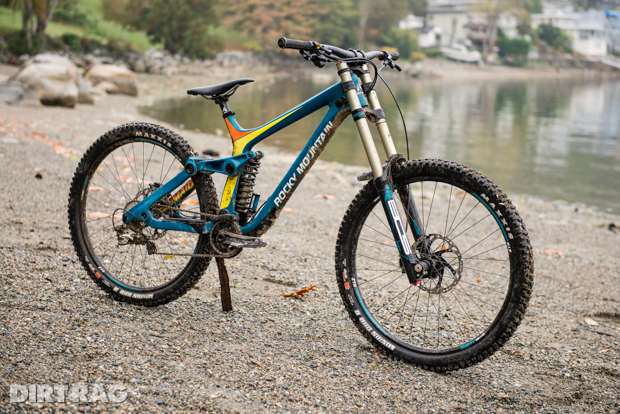
Overview
Like many riders, I fell victim to the enduro bike bug. After almost 15 years of owning various downhill bikes, this was finally the year I said goodbye to owning a gravity-specific rig. Despite my admiration for long, slack, one-trick ponies, the gear nerd in me couldn’t help but wonder if there was a bike out there that could fulfill my gravity needs but still allow me to pedal. I ended up with one of the latest superbikes with six inches of travel, and it kept me well-equipped throughout this past summer of bike park and trail riding.
When my yearly pilgrimage to Whistler began looming, I started wondering what the heck would I ride. Just before leaving, I was presented with the opportunity to test Rocky Mountain’s brand new Maiden DH Bike.

Rocky Mountain freerider Thomas Vanderham was clear on Rocky’s intent during this bike’s three-year design process; he did not want to simply recreate a carbon fiber Flatline (the Maiden’s predecessor). Part of the Maiden’s beauty is the environment in which it was conceived: Rocky Mountain’s headquarters on the North Shore of Vancouver. The company’s close proximity to some of the most storied trails in the world, along with the ability to produce prototypes on site, provided the perfect recipe for the Maiden.
More than 20 aluminum prototype mules were developed, which allowed Vanderham and Geoff Gulevich to pilot the bikes in locations around the world including events like Redbull Rampage. By using this incremental prototype process, they were able to dial in the perfect ride.
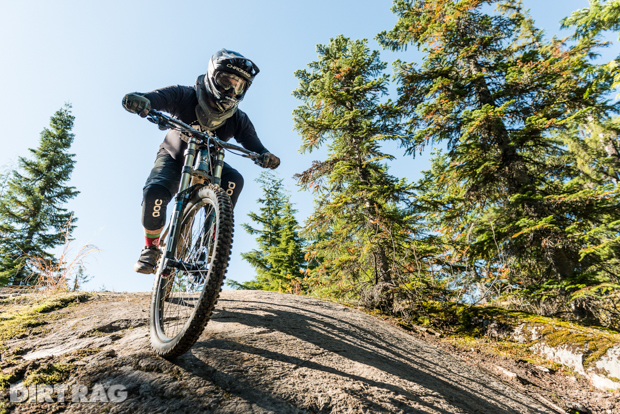
The Maiden’s 200 mm travel frame is fully constructed of carbon fiber (no aluminum rear end, here). Rocky Mountain also developed a new downhill-specific version of its SmoothLink suspension system with massive bearings to handle the stress of aggressive riders and trails.
Vanderham informed me the focus was on dialing in the stock geometry, not providing the customer large variations in adjustment choices. That said, the Maiden does allow for a small adjustment to fine tune your ride using the Ride-4 chip system, which allows for a 0.8-degree change in the headtube angle (from 63-63.8 degrees).
The Build
Rocky Mountain decided on BOS suspension for the World Cup model using the Idyll Air up front and the Stoy Rare coil shock out back. French manufacturer BOS was new to me, but it is gaining ground in North America. The proven Shimano Saint group handles shifting and braking duties. To keep the Maiden rolling straight, Rocky Mountain included a Stan’s NoTubes wheelset and mounted up a set of Maxxis Minion DHR II tubeless tires.

After picking up the Maiden in North Vancouver, my Whistler-bound crew stopped for a quick bite and began pointing out the finer details of the Maiden. If you start at the head tube and follow the frame, you will first notice the integrated fork bumper stops on the sides of the head tube, a must for any new DH bike. The cable routing on this bike is fully internal and, additionally, Rocky Mountain decided to future-proof the Maiden by making it fully Di2 compatible.

Move along and you will notice integrated rubber frame protection and an ultra cool shark fin-looking fender to protect the shock from trail debris. The final touch to the frame are the giant bearings, probably the largest I have ever seen on a bike, which look to be very durable. Finally, I dig the paint; it is a refreshing change from the current day-glow trend and looks somewhat ATARI-inspired. If blue isn’t your thing, Rocky Mountain offers other Maiden models in a stealthy black colorway.
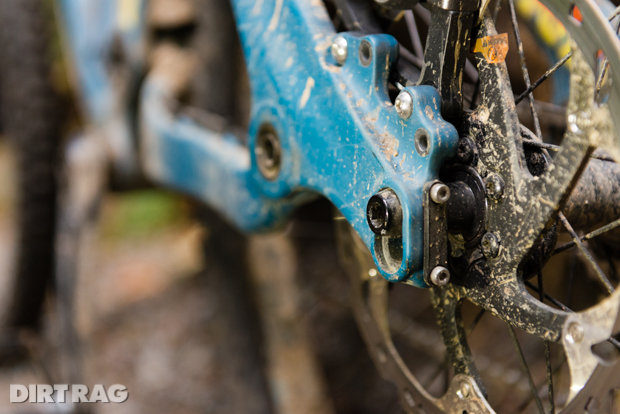
For all of you 26-inch holdouts, Rocky Mountain has you covered. All models of the Maiden ship with 27.5 wheels but include a secondary rear wheel position and a lower headtube spacer to dial the Maiden in for use with 26-inch wheels.
The Ride
I had the opportunity to ride the Maiden in some of the best terrain imaginable over multiple days in Whistler’s Bike Park, shuttle runs in Pemberton and along trails on the North Shore. My first run on the bike was in Whistler’s Garbanzo Zone, down O-Sin to the Whistler Village. The upper trails dive right into the thick of things immediately off the lift, leaving zero time to get acquainted with a new bike.

One of the Maiden’s strengths became apparent immediately: stability. I rode the bike in the long and slack mode the entire test. I don’t know if it was lack of due diligence or just pure laziness, but I didn’t feel the need to steepen the head angle. Vanderham agreed, saying he never runs the bike in anything but the slackest setting.
I was astonished at how quickly the Maiden felt like my bike; it was rock solid with neutral handling and didn’t do anything unpredictable. The 63-degree head angle is the slackest I’ve ever ridden; it offered good stability when things got fast and steep while the short chainstays kept the handling lively.
The geometry put me in the exact commanding spot I wanted to be in for steep, gnarly sections of trail and I found myself riding lines I have ridden for years with more speed and confidence than ever before. Chutes that looked downright terrible were smoothed out and left me looking for even more formidable lines. In the air, the bike was very neutral and loved to be popped off of lips and trail obstacles.

The Shimano Saint brakes performed perfectly shutting down my speed whenever called upon. The Saint derailleur/shifter combination was rock solid, paired with the new e.13 chain retention system helped keep the bike ultra quiet.
After a few days of riding in Whistler Bike Park, you realize that almost anything you encounter on the trail is rollable with the right technique. Great care is taken to make the park as “safe” as possible for its riders. Knowing this, I wanted to take the Maiden out of the bike park to see how it would handle some less civilized terrain, so my friends and I drove north of Whistler and up the side of a mountain on a 4×4 road, arriving at the trailhead for Gravitron.

Gravitron is an aggressive trail that was originally built with DH bikes in mind. The trail is raw, unforgiving and unpredictable, especially on your first run. Dropping in, the Maiden again became my best friend. Steep, jagged rock sections are commonplace on this trail. There, the Maiden’s geometry and suspension kept me in control on sustained, behind-the-seat descents that would have given me trouble on my six-inch travel bike.
Suspension
I’ve heard good things about the BOS suspension from other riders, so I was eager to get a crack at those French bits, myself. I set the suspension to the manufacturer’s recommendations prior to riding, but found those settings a bit soft and needed to add a bit more compression to the fork. No problem; just turn a few knobs, right? Wrong. BOS’s adjustments need to be done with a flathead screwdriver. The thought process is that the rider will do more methodical and thoughtful adjustments if required to use a tool. Cane Creek has a similar setup on its rear shocks for the same reason.
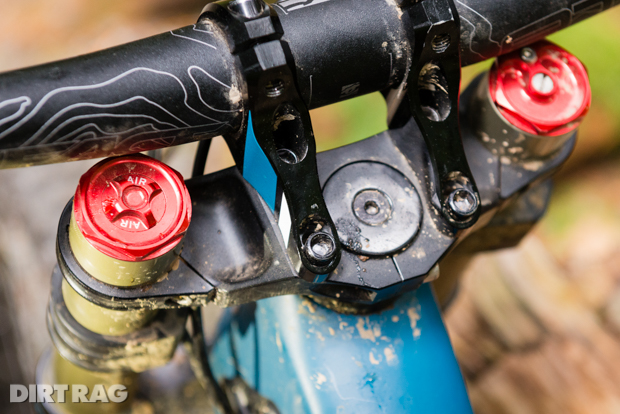
While applaud BOS for its theology, I don’t buy it. Riders purchasing high-end suspension like to be able to make trailside adjustments and most of us don’t carry a screwdriver in the bike park. Once I got the fork dialed at the base of the mountain it was excellent. The fork stayed high in its travel, offering a firm platform in the steeps while still providing great small bump performance.
The same can be said for the rear shock—it disappeared under me, which I personally take to be a sign that I am riding a quality product. I only bottomed it out on rare occasions, and those times were due to my lack of landing smoothly or taking a misjudged line.
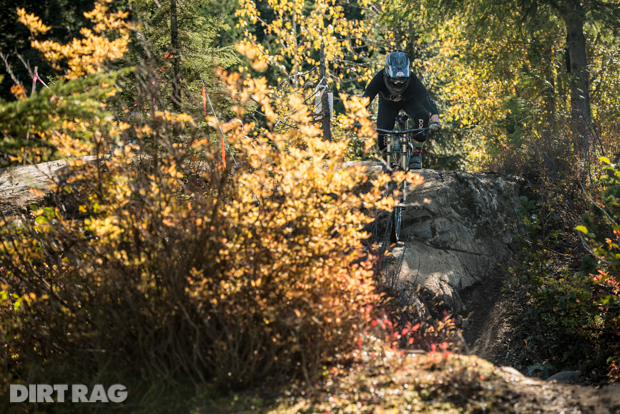
The bike park can be a vicious place, it sees hundreds of thousands of riders each year which takes a heavy toll on its precious soil. Because of the traffic, Whistler develops serious braking bumps. Rocky Mountain’s Smoothlink suspension design keeps the suspension active even when braking. Paired with the vibration damping characteristics of the frame, the Maiden has an uncanny ability to smooth out braking bumps, reducing rider fatigue and ultimately resulting in longer days and more fun.
Summary
When buying a downhill bike, you need to be honest with yourself about your intentions. Will an all-mountain bike be enough for your gravity needs? For the majority of riders, the answer is probably “yes.” But for those riders who spend most of their time on lift-served or shuttle trails, there is no better tool for the job than a true downhill bike.

I skirt that line pretty close. I can say that without this bike, my time in British Columbia would not have been as enjoyable. I absolutely loved the Maiden; there is essentially nothing negative I can say about it. If you were reading this review to be talked out of spending your next several paychecks on the Rocky Mountain, sorry; it’s just too much fun to talk you out of.
The feature I found most compelling about the bike was the depth of thought put into the development. With the Maiden, Rocky Mountain checks essentially every box that an aspiring or established big mountain rider desires. Whether you are an up and coming racer, a big mountain freerider, or just an average Joe that likes to spend his or her weekends going hard in the bike park, the Maiden will not let you down.
- Reach:16.3-16.6”
- Stack: 23.9-24.1”
- Top Tube; 23.1”
- Head Tube: 63-63.8˚
- Seat Tube: 73.9-74.9˚
- BB Drop: .05-.4”
- Chainstays: 16.7”
- Weight: 35.9 lbs. (claimed)
- Price: $6,999
- Sizes: S, M(Tested), L, XL
- Online: bikes.com